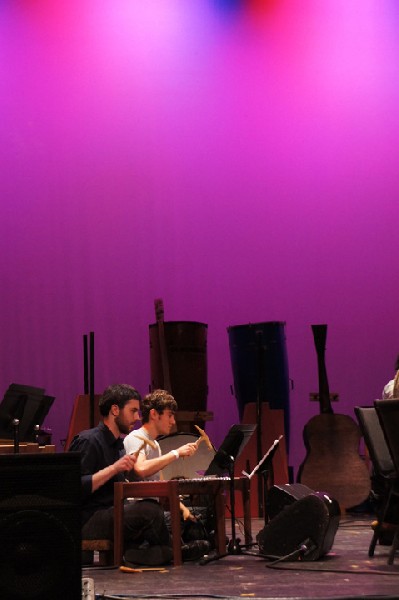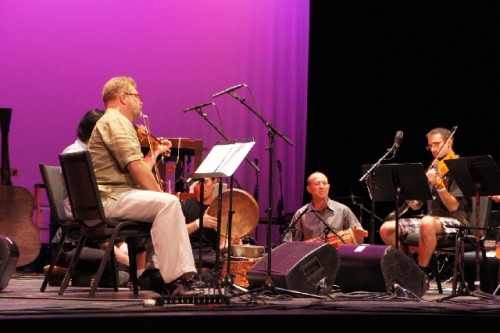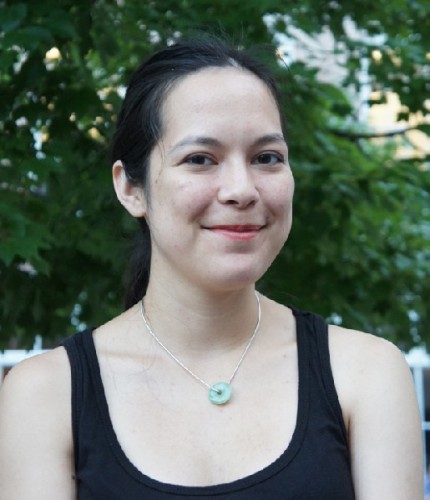Bang on a Can at Mass MoCA
Annual Banglewood Music Marathon
By: Stephanie Farrington - Aug 03, 2011
Back in the days before the internet existed, people paid to read newspapers and magazines. They didn’t pay much. In fact, they usually paid barely enough to cover printing and delivery costs, sometimes not even that.
Subscriptions to papers were desirable not as a source of income but because they gave publishers proof of circulation - the number of subscribers to a paper were a kind of readership bank. When advertising salespeople went out to do their jobs, they were able to say their publication reached a minimum of X number of homes on a regular basis. This made the publication desirable and helped to fix advertising rates and the sale of advertising is what paid for writers, photographers, layout artists and all of the other expenses involved in putting the news on the page.
So what has this got to do with Bang on a Can? I mention this seemingly forgotten aspect of publishing for a number of reasons: first, although publishers may be pretending this was never the case, smart organizations like Bang on a Can have not forgotten this dynamic at all, in fact, it’s part what makes their Festival so successful.
Although the Bang on a Can Summer Festival and Institute is often referred to as Banglewood, the similarity really does end there. If attendance is down, that’s okay cause Bang On A Can isn’t banking on an audience to succeed. It may be a festival but it’s also an Institute and that means money generated by ticket sales is pretty much beside the point. Ticket sales to Bang On A Can are like subscriptions to newspapers or magazines, they don’t pay the bills, rather they provide a more-or-less accurate measure of public reception.
Banglewood is for musicians. It costs money to attend the Institute and professional gains are made by those attending. The Institute is also funded by sponsors and grants. You, as a breathing, listening, applauding member of the audience are nice to have around but you’re the gravy.
This is worth remembering for a few reasons: First, it means if you do the research on the musicians performing, you’ll often be able to catch concerts that appeal to your tastes in Mass MoCA’s galleries for free. In fact, except for the Marathon, they’re all free.
Second, people struggling in the arts around the Berkshires could take a lesson from Bang On A Can. They’ve diversified their funding sources and therefore made themselves much more secure than a production company relying solely on ticket sales.
Third, and somewhat peripherally, it should remind you that all this noise you hear about newspapers and magazines needing subscriber revenue in order to exist on line is piffle. Publications need ad revenue and the content of advertising, the source of that revenue, like the student musicians at the Bang On a Can summer institute, will tell you much more about the bias of a publication than any other single fact.
So Bang On A Can is not there for you. You are there, if you want to be there, to participate as an audience member but that’s where it begins and ends. This means the musicians can create music without regard for the tastes of their audience.
And they do.
Banglewood’s big ticket item is the marathon at the end of the festival. $35. buys you six hours of all you can hear contemporary music. You are free to wander in and out as you please. If you get hungry, the cafe is always open. If you dislike a piece, you may leave and return when something you think you’ll like is performed. There are surprises, there is drama and yes, there’s some cacophony.
This was my first year attending Bang On A Can as an audience member. I understand that their All Star performances are much more accessible. I will disclose, I have training and performance experience as a more conventional musician and my patience for atonal composition and noise music are pretty low. Nevertheless, I did find a lot to enjoy at the Banglewood marathon and I did stay for the whole thing.
Super Collider by Christine Southworth was pure delight. The piece was written around an instrument called a gamelan elektrika developed by M.I.T.
The instrument does what a traditional gamelan does and then some, it’s able to make bird sounds, chimes - whatever is needed. Listening to the piece you feel as though you are in a forest in Indonesia at first, hearing mysterious bells and rhythms from a hidden ritual but as the piece progresses the audience is moved through what feels like a crowded marketplace complete with traffic jam, even a runway. You could practically smell spices in the air and feel the jungle around you.
The musicians looked happy too. It was pure delight. Looking around, I wasn’t the only one who felt that way, throughout the piece, the audience nodded and beamed. It was exceptional music by an exceptional young composer. Worth the price of admission by itself.
Mark Stewart is a veteran Banglewood performer. He’s been performing with the company since 1989. His composition “Whirlies, Balloon Horns and The Return of the Nine Foot Banjo” performed on home-made instruments, was another crowd pleaser enhanced by the vocal part of the performance where all of the performers stopped what playing for a few beats and shouted “Go North Adams SteepleCats - Go North Adams SteepleCats.” How many home-town teams have a cheer composed for them by “serious” composers?
There was a sweet and mournful piece by Osvaldo Golijov, (who was raised in Argentina but is now local to the Berkshires) titled Tenebrae, in which a string quartet and solo vocalist (Illinois soprano, Jamie Jordan) performed a seamless and heart wrenching melodic line that seemed to begin and end out of nowhere.
The “traditional ensemble” featuring musicians from Uzbekistan was less traditional than expected with the inclusion of an electric guitar and drums. It broke into a kind of jam session where the Uzbeki vocalist Mansur Saparbaev, gave a performance that was strangely reminiscent of Jimmy Page in Led Zepplin and capped it off with a smokin’ hot dutar solo into the bargain.
Another stand-out was a comic piece where the performers exchanged instruments, froze for 4 beats at a time and at one point, all clustered around and played the same piano simultaneously.
Then there were pieces that made me think; “This is why classical musicians should not be allowed to transcribe jazz.” There were noise pieces and pieces that were boring or painful to my ear. I stuck around for some of them and some of them? I wish I hadn’t.
During a break I had the chance to talk to some of the musicians. That’s another part of what makes this festival great. If you want to interact with the next generation of serious contemporary composers, they are well represented here only they’re not being terribly serious.
In the courtyard, musicians smoked and gossiped, discussing gigs and performances as though they were playing in touring rock bands.
Percussionist, Ben Reimer and Violinist Patti Kilroy answered a few of my questions:
“Why did I come?” says Patti, “I came last year and I came back cause it was awesome. I like the music, I feel it has a particular aesthetic that suits me.”
Ben is pursuing a Phd in percussion at McGill University in Montreal, Canada. He got down to the essence of it. “It’s a pretty little community and you meet a ton of people here, that’s for sure. I’ve made lots of connections.” Patti agreed. “Then there are workshops on managing your career, dealing with money, music software, all of it. It’s extremely valuable to be here and something else I’ll take away is a bigger belly from all the beer.”
For a tuition fee of around $2000, each participant is given a place to stay, dormitory style, two meals a day for weekdays and access to all the workshops. They perform as part of the experience.
Bang On A Can and Mass MoCA have a symbiotic relationship that also benefits North Adams. The community is gaining a strong reputation amongst contemporary classical musicians, some of whom have moved here and of course there are the economic spin-offs to having extra visitors attend the festival for three weeks every summer. People need to eat and have somewhere to stay, after all.
The most important of Bang On A Can is also the part that makes it the biggest risk to attend, the performers are mostly long, mostly academic, mostly avant garde musicians who aren’t pandering to their audience and in this venue, they really stretch themselves to see where music can go.
Of course the audience is not left out of this process. Speaking to several audience members it was clear that they all valued the exposure to new ways of exploring music. Some loved the pieces I hated (and yes, there were pieces I hated) and some - not so much but all age groups were represented and although the place may not have sold out, it’s safe to say a good time was had by all.
One of the organizers told me a story about the Uzbeki musicians and how eager they were to be here. Apparently, they had heard so many positive things about the festival and North Adams from colleagues in Asia that they were completely underwhelmed by their time in New York City. Asked about NYC, they seemed to feel they were just filling in time until the festival began but they were excited to come to North Adams, the quirky, artistic community they had been hearing about for years.
Musicians from all over the world come to North Adams to be at Bang On A Can. This year, there was a large Australian delegation as well as musicians from Canada, Europe and all over the U.S.
Banglewood should be an example to anyone who wants to make a living in the arts. Diversity of purpose and funding is key to survival these days and supporting each other to extend your reach as Mass MoCA and Bang On A Can have for the last ten years is what it’s all about.
When I left, they were toasting. Banglewood celebrated their 10th anniversary this year and is looking forward to a strong ten more and that’s something, for any number of reasons, we should all raise a glass to.





